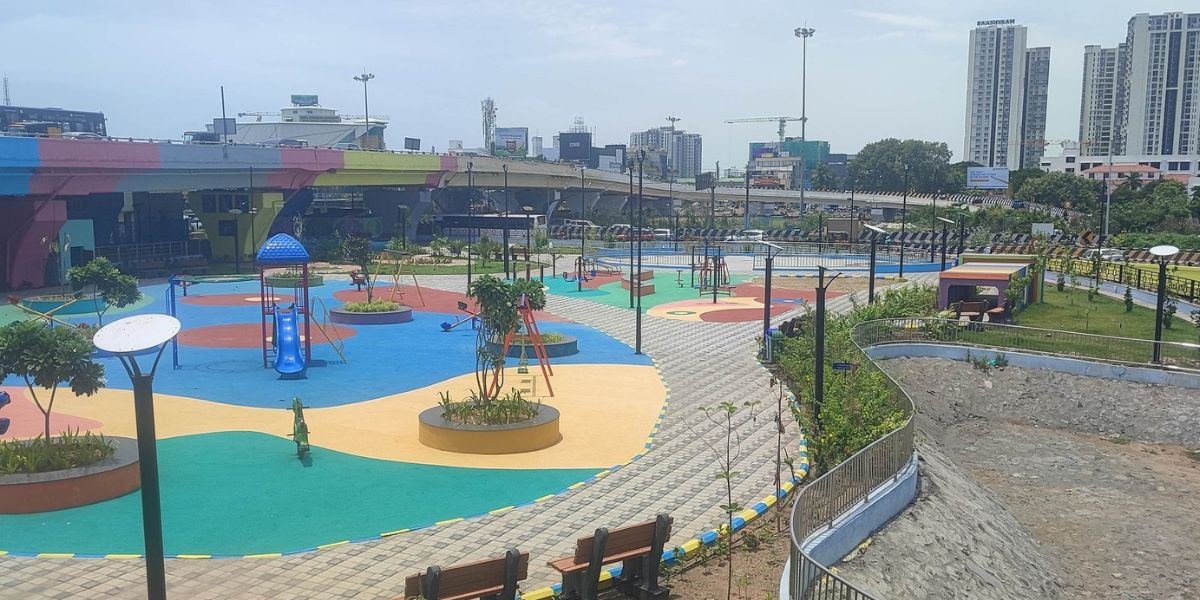The pattern observed in Chennai, where women visit parks mainly in the evening after completing household and caregiving responsibilities, is not unique to the city.
Published Sep 14, 2025 | 7:00 AM ⚊ Updated Sep 14, 2025 | 7:00 AM

A public park in Chennai's Koyambedu.
Synopsis: Women in Chennai step into public parks, usually after sunset while men tend to dominate mornings with walking, jogging or informal sports. Evening visits for women are not merely leisure activities; they are often layered with caregiving, which influences the amenities and safety measures they prioritise.
Women in Chennai step into public parks, usually after sunset, often balancing personal exercise with childcare responsibilities, while men tend to dominate mornings with walking, jogging or informal sports.
This temporal difference creates two distinct experiences within the same park, shaping how each gender interacts with the space. Evening visits for women are not merely leisure activities; they are often layered with caregiving, which influences the amenities and safety measures they prioritise.
These patterns, captured through Gender Lab studies and community consultations, informed the Greater Chennai Corporation’s Inclusive Design Manual.
The manual recommends practical measures such as secure pathways, frequent seating near children’s play areas, and accessible toilets, emphasising that parks cannot be truly inclusive unless they account for women’s specific needs.
The timing, purpose, and context of park visits, therefore, play a crucial role in determining how these public spaces are experienced.
Survey data from 567 respondents across the city highlight a pronounced gender gap in park usage. While 43 percent of men reported visiting a park daily, only 29 percent of women did the same, reflecting not just differences in frequency but also in the timing of visits.
Men overwhelmingly preferred morning hours between 6 am and 12 pm, while women’s visits were concentrated after 6 pm, often after completing household chores or school pickups. Many women brought children along, combining personal exercise with caregiving responsibilities, which adds complexity to their experience of these public spaces.
The evening-centred pattern of women’s park use also elevates safety concerns. According to the surveys, 24 percent of women identified improved toilets as their most urgent need, and 20 percent highlighted the importance of better overall infrastructure. Poor lighting, limited visibility, and insecure pathways contribute to a sense of vulnerability after dark.
Focus group discussions added further practical recommendations: Better lighting, CCTV cameras, stricter enforcement of rules, seating near children’s play areas and women-only timings. Facilities supporting caregiving, such as feeding rooms and diaper-changing spaces, were also cited as essential.
Together, these findings illustrate that parks, though public by design, are not experienced uniformly by men and women. Incorporating these insights into design and maintenance decisions is crucial to making Chennai’s 835 parks accessible, safe, and welcoming for all users.
The pattern observed in Chennai, where women visit parks mainly in the evening after completing household and caregiving responsibilities, is not unique to the city. Similar trends emerge globally, reflecting deeper inequalities in how men and women spend their leisure time.
Research from the GenTime project, led by Professor Man-Yee Kan and Dr Grace Chang, underscored what the researchers describe as a “stalled gender revolution”.
Between the 1980s and 2000s, gender gaps in paid and unpaid work began to narrow as women entered higher education in larger numbers and participated more in paid employment, reducing the time they spent on domestic tasks.
However, since the 2000s, progress has slowed down. Men have lagged in increasing their contribution to unpaid domestic work, and the tasks they do take on tend to be more “gender-neutral,” such as DIY or gardening, rather than cooking or cleaning, which remain women’s responsibility.
These imbalances are rooted in patterns established from an early age. Boys tend to have more leisure time and physical activity, while girls are expected to take on household chores even in childhood.
Since leisure and exercise are closely linked to mental and physical well-being, these early patterns help explain why women continue to carry a disproportionate share of domestic responsibilities, even as they participate more in paid work.
Professor Kan emphasised the role of policy in addressing these inequalities: “We need proactive policies that challenge gender essentialism, the idea that men should be the breadwinners and women the primary caregivers.”
Measures such as flexible working, paid parental leave, and improved support for childcare can help close these gaps. However, policies alone are not enough; cultural shifts are equally important, encouraging men to share unpaid work and challenging stereotypes about who is “supposed” to do what.
Dr. Chang added, “Time is a resource, and it reflects power. Who gets to decide how to spend their time? By understanding and addressing gender inequalities in time use, we can build a more gender-equal society.”
By linking the Chennai findings to this global context, it becomes clear that women’s concentrated evening park visits are part of larger societal patterns.
Addressing these imbalances requires both local interventions, like safer, women-friendly parks, and broader structural and cultural changes that redistribute time and responsibilities more equitably.
(Edited by Muhammed Fazil.)
